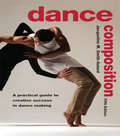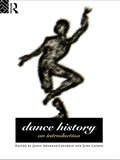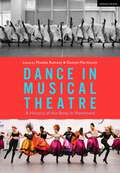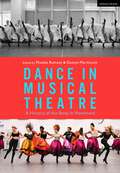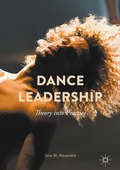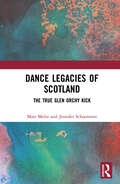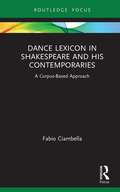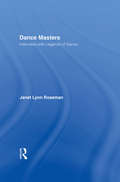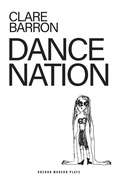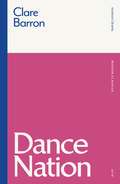- Table View
- List View
The Dance and Opera Stage Manager's Toolkit: Protocols, Practical Considerations, and Templates (The Focal Press Toolkit Series)
by Susan Fenty Studham Michele KayThe Dance and Opera Stage Manager’s Toolkit details unique perspectives and approaches to support stage managers beginning to navigate the fields of dance and opera stage management in live performance.This book demystifies the genre-specific protocols and vocabularies for stage managers who might be unfamiliar with these fields and discusses common practices. Filled with valuable industry-tested tools, templates, and practical information, The Dance and Opera Stage Manager’s Toolkit is designed to assist stage managers interested in pursuing these performance genres. The book also includes interviews and contributions from a range of professional stage managers working in dance and opera.From the student stage manager studying in Theatrical Design and Production university programs to the experienced stage manager wanting to broaden their skill set, this book provides resources and advice for a successful transition into these worlds.The Dance and Opera Stage Manager’s Toolkit includes access to an online repository of resources and paperwork examples to help jumpstart the reader’s journey into dance and opera stage management. To access these resources, visit www.routledge.com/9780367566579.
Dance Composition: A Practical Guide to Creative Success in Dance Making (Ballet, Dance, Opera And Music Ser. #3)
by Jacqueline M. Smith-AutardFirst Published in 2005. Routledge is an imprint of Taylor & Francis, an informa company.
Dance Composition: A Practical Guide to Creative Success in Dance Making
by Jacqueline M. Smith-AutardFirst Published in 2005. Routledge is an imprint of Taylor & Francis, an informa company.
Dance Discourses: Keywords in Dance Research
by Susanne Franco Marina NorderaFocusing on politics, gender, and identities, a group of international dance scholars provide a broad overview of new methodological approaches – with specific case studies – and how they can be applied to the study of ballet and modern dance. With an introduction exploring the history of dance studies and the development of central themes and areas of concerns in the field, the book is then divided into three parts: politics explores 'Ausdruckstanz' – an expressive dance tradition first formulated in the 1920s by dancer Mary Wigman and carried forward in the work of Pina Bausch and others gender examines eighteenth century theatrical dance – a time when elaborate sets, costumes, and plots examined racial and sexual stereotypes identity is concerned with modern dance. Exploring contemporary analytical approaches to understanding performance traditions, Dance Discourses' pedagogical structure makes it ideal for courses in performing arts and humanities.
Dance Discourses: Keywords in Dance Research
by Susanne Franco Marina NorderaFocusing on politics, gender, and identities, a group of international dance scholars provide a broad overview of new methodological approaches – with specific case studies – and how they can be applied to the study of ballet and modern dance. With an introduction exploring the history of dance studies and the development of central themes and areas of concerns in the field, the book is then divided into three parts: politics explores 'Ausdruckstanz' – an expressive dance tradition first formulated in the 1920s by dancer Mary Wigman and carried forward in the work of Pina Bausch and others gender examines eighteenth century theatrical dance – a time when elaborate sets, costumes, and plots examined racial and sexual stereotypes identity is concerned with modern dance. Exploring contemporary analytical approaches to understanding performance traditions, Dance Discourses' pedagogical structure makes it ideal for courses in performing arts and humanities.
Dance History: An Introduction
by Janet Adshead-Lansdale June LaysonOriginally published in 1983 the first edition rapidly established itself as a core student text. Now fully revised and up-dated it remains the only book to address the rationale, process, techniques and methodologies specific to the study of dance history. For the main body of the text which covers historical studies of dance in its traditional and performance contexts, the editors have brought together a team of internationally known dance historians. Roger Copeland and Deborah Jowitt each take a controversial look at the modern American dance. Kenneth Archer and Millicent Hodson explain the processes they use when reconstructing 'lost' ballets, and Theresa Buckland and Georgina Gore write on traditional dance in England and West Africa respectively. With other contributions on social dance, ballet, early European modern dance and feminist perspectives on dance history this book offers a multitude of starting points for studying dance history as well as presenting examples of dance writing at its very best. Dance History will be an essential purchase for all students of dance.
Dance History: An Introduction
by Janet Adshead-Lansdale June LaysonOriginally published in 1983 the first edition rapidly established itself as a core student text. Now fully revised and up-dated it remains the only book to address the rationale, process, techniques and methodologies specific to the study of dance history. For the main body of the text which covers historical studies of dance in its traditional and performance contexts, the editors have brought together a team of internationally known dance historians. Roger Copeland and Deborah Jowitt each take a controversial look at the modern American dance. Kenneth Archer and Millicent Hodson explain the processes they use when reconstructing 'lost' ballets, and Theresa Buckland and Georgina Gore write on traditional dance in England and West Africa respectively. With other contributions on social dance, ballet, early European modern dance and feminist perspectives on dance history this book offers a multitude of starting points for studying dance history as well as presenting examples of dance writing at its very best. Dance History will be an essential purchase for all students of dance.
Dance in Contested Land: New Intercultural Dramaturgies (New World Choreographies)
by Rachael SwainThis book traces an engagement between intercultural dance company Marrugeku and unceded lands of the Yawuru, Bunuba, and Nyikina in the north west of Australia. In the face of colonial legacies and extractive capitalism, it examines how Indigenous ontologies bring ecological thought to dance through an entangled web of attachments to people, species, geologies, political histories, and land. Following choreographic interactions across the multiple subject positions of Indigenous, settler, and European artists between 2012–2016 the book closely examines projects such as Yawuru/Bardi dancer and choreographer Dalisa Pigram’s solo Gudirr Gudirr (2013) and the multimedia work Cut the Sky (2015). Dance in Contested Land reveals how emergent intercultural dramaturgies can mediate dance and land to revision and reorientate kinetics, emotion, and responsibilities through sites of Indigenous resurgence and experimentation.
Dance in Musical Theatre: A History of the Body in Movement
by Dustyn Martincich and Phoebe RumseyFrom Oklahoma! and West Side Story, to Spring Awakening and Hamilton, dance remains one of the most important and key factors in musical theatre. Through the integration of song and dance in the 'dream ballets' of choreographers like Agnes De Mille; the triple threat performances of Jerome Robbins' dancers; the signature style creation by choreographers like Bob Fosse with dancers like Gwen Verdon; and the contemporary, identity-driven work of choreographers like Camille A. Brown, the history of the body in movement is one that begs study and appreciation. Dance in Musical Theatre offers guidelines in how to read this movement by analyzing it in terms of composition and movement vocabulary whilst simultaneously situating it both historically and critically. This collection provides the tools, terms, history, and movement theory for reading, interpreting, and centralizing a discussion of dance in musical theatre, importantly, with added emphasis on women and artists of color. Bringing together musical theatre and dance scholars, choreographers and practitioners, this edited collection highlights musical theatre case studies that employ dance in a dramaturgically essential manner, tracking the emergence of the dancer as a key figure in the genre, and connecting the contributions to past and present choreographers. This collection foregrounds the work of the ensemble, incorporating firsthand and autoethnographic accounts that intersect with historical and cultural contexts. Through a selection of essays, this volume conceptualizes the function of dance in musical: how it functions diegetically as a part of the story or non-diegetically as an amplification of emotion, as well as how the dancing body works to reveal character psychology by expressing an unspoken aspect of the libretto, embodying emotions or ideas through metaphor or abstraction.Dance in Musical Theatre makes dance language accessible for instructors, students, and musical theatre enthusiasts, providing the tools to critically engage with the work of important choreographers and dancers from the beginning of the 20th century to today.
Dance in Musical Theatre: A History of the Body in Movement
From Oklahoma! and West Side Story, to Spring Awakening and Hamilton, dance remains one of the most important and key factors in musical theatre. Through the integration of song and dance in the 'dream ballets' of choreographers like Agnes De Mille; the triple threat performances of Jerome Robbins' dancers; the signature style creation by choreographers like Bob Fosse with dancers like Gwen Verdon; and the contemporary, identity-driven work of choreographers like Camille A. Brown, the history of the body in movement is one that begs study and appreciation. Dance in Musical Theatre offers guidelines in how to read this movement by analyzing it in terms of composition and movement vocabulary whilst simultaneously situating it both historically and critically. This collection provides the tools, terms, history, and movement theory for reading, interpreting, and centralizing a discussion of dance in musical theatre, importantly, with added emphasis on women and artists of color. Bringing together musical theatre and dance scholars, choreographers and practitioners, this edited collection highlights musical theatre case studies that employ dance in a dramaturgically essential manner, tracking the emergence of the dancer as a key figure in the genre, and connecting the contributions to past and present choreographers. This collection foregrounds the work of the ensemble, incorporating firsthand and autoethnographic accounts that intersect with historical and cultural contexts. Through a selection of essays, this volume conceptualizes the function of dance in musical: how it functions diegetically as a part of the story or non-diegetically as an amplification of emotion, as well as how the dancing body works to reveal character psychology by expressing an unspoken aspect of the libretto, embodying emotions or ideas through metaphor or abstraction.Dance in Musical Theatre makes dance language accessible for instructors, students, and musical theatre enthusiasts, providing the tools to critically engage with the work of important choreographers and dancers from the beginning of the 20th century to today.
Dance Leadership: Theory Into Practice
by Jane M. AlexandreThis “what is”—rather than “how to”— volume proposes a theoretical framework for understanding dance leadership for dancers, leaders, and students of both domains, illustrated by portraits of leaders in action in India, South Africa, UK, US, Brazil and Canada. What is dance leadership? Who practices it, in what setting, and why? Through performance, choreography, teaching, writing, organizing and directing, the dance leaders portrayed herein instigate change and forward movement. Illustrating all that is unique about leading in dance, and by extension the other arts, readers can engage with such wide-ranging issues as: Does the practice of leading require followers? How does one individual’s dance movement act on others in a group? What does ‘social engagement’ mean for artists? Is the pursuit of art and culture a human right?
Dance Legacies of Scotland: The True Glen Orchy Kick
by Mats Melin Jennifer SchoonoverDance Legacies of Scotland compiles a collage of references portraying percussive Scottish dancing and explains what influenced a wide disappearance of hard-shoe steps from contemporary Scottish practices. Mats Melin and Jennifer Schoonover explore the historical references describing percussive dancing to illustrate how widespread the practice was, giving some glimpses of what it looked and sounded like. The authors also explain what influenced a wide disappearance of hard-shoe steps from Scottish dancing practices. Their research draws together fieldwork, references from historical sources in English, Scots, and Scottish Gaelic, and insights drawn from the authors’ practical knowledge of dances. They portray the complex network of dance dialects that existed in parallel across Scotland, and share how remnants of this vibrant tradition have endured in Scotland and the Scottish diaspora to the present day. This book will be of interest to scholars and students of Dance and Music and its relationship to the history and culture of Scotland.
Dance Legacies of Scotland: The True Glen Orchy Kick
by Mats Melin Jennifer SchoonoverDance Legacies of Scotland compiles a collage of references portraying percussive Scottish dancing and explains what influenced a wide disappearance of hard-shoe steps from contemporary Scottish practices. Mats Melin and Jennifer Schoonover explore the historical references describing percussive dancing to illustrate how widespread the practice was, giving some glimpses of what it looked and sounded like. The authors also explain what influenced a wide disappearance of hard-shoe steps from Scottish dancing practices. Their research draws together fieldwork, references from historical sources in English, Scots, and Scottish Gaelic, and insights drawn from the authors’ practical knowledge of dances. They portray the complex network of dance dialects that existed in parallel across Scotland, and share how remnants of this vibrant tradition have endured in Scotland and the Scottish diaspora to the present day. This book will be of interest to scholars and students of Dance and Music and its relationship to the history and culture of Scotland.
Dance Lexicon in Shakespeare and His Contemporaries: A Corpus Based Approach (Studies in Performance and Early Modern Drama)
by Fabio CiambellaThis book provides a thorough analysis of terpsichorean lexis in Renaissance drama. Besides considering not only the Shakespearean canon but also the Bard’s contemporaries (e.g., dramatists as John Marston and Ben Jonson among the most refined Renaissance dance aficionados), the originality of this volume is highlighted in both its methodology and structure. As far as methods of analysis are concerned, corpora such as the VEP Early Modern Drama collection and EEBO, and corpus analysis tools such as #LancsBox are used in order to offer the widest range of examples possible from early modern plays and provide co-textual references for each dance. Examples from Renaissance playwrights are fundamental for the analysis of connotative meanings of the dances listed and their performative, poetic and metaphoric role in sixteenth- and seventeenth-century drama. This study will be of great interest to Renaissance researchers, lexicographers and dance historians.
Dance Lexicon in Shakespeare and His Contemporaries: A Corpus Based Approach (Studies in Performance and Early Modern Drama)
by Fabio CiambellaThis book provides a thorough analysis of terpsichorean lexis in Renaissance drama. Besides considering not only the Shakespearean canon but also the Bard’s contemporaries (e.g., dramatists as John Marston and Ben Jonson among the most refined Renaissance dance aficionados), the originality of this volume is highlighted in both its methodology and structure. As far as methods of analysis are concerned, corpora such as the VEP Early Modern Drama collection and EEBO, and corpus analysis tools such as #LancsBox are used in order to offer the widest range of examples possible from early modern plays and provide co-textual references for each dance. Examples from Renaissance playwrights are fundamental for the analysis of connotative meanings of the dances listed and their performative, poetic and metaphoric role in sixteenth- and seventeenth-century drama. This study will be of great interest to Renaissance researchers, lexicographers and dance historians.
Dance Like No One's Watching (SING #2)
by Vanessa JonesThe show must go on.It’s back to show business as usual at Duke’s Academy of Performing Arts. Things are finally working out for Nettie, with her voice restored, her gorgeous boyfriend, Fletch, by her side and the lead role in the college musical.That is, until Fletch is offered the opportunity of a lifetime miles away from London and a TV company invades Dukes, pitting Nettie against old enemy Jade Upton and pulling her friends apart. As she tries to juggle the impossible pressure to perform and following her heart, Nettie discovers secrets about her mother that make her question everything she ever knew. Will Fletch come back? Will the stage ever feel like home? And will she ever find out the truth about her mother? Nettie is determined to find out. Dance Like No One's Watching by Vanessa Jones will show that Nettie is not helpless, and we'd better listen.
Dance Masters: Interviews with Legends of Dance
by Janet Lynn RosemanDance Masters is a lively ensemble of conversations with seven celebrated dancers and choreographers. In these intimate interviews, dance critic Janet Lynn Roseman probes the heart of dance: * The creative process * The role of dream and rituals * The interplay between dancer and audience * The spiritual aspects of performance These dance masters offer rare insights into the internal world of the artist as they reveal their philosophies on dance training, discuss their mentors, and speak candidly about the artistic process of dance-making and how it actually feels to dance.
Dance Masters: Interviews with Legends of Dance
by Janet Lynn RosemanDance Masters is a lively ensemble of conversations with seven celebrated dancers and choreographers. In these intimate interviews, dance critic Janet Lynn Roseman probes the heart of dance: * The creative process * The role of dream and rituals * The interplay between dancer and audience * The spiritual aspects of performance These dance masters offer rare insights into the internal world of the artist as they reveal their philosophies on dance training, discuss their mentors, and speak candidly about the artistic process of dance-making and how it actually feels to dance.
Dance, Modernity and Culture
by Helen ThomasFirst published in 1995. Routledge is an imprint of Taylor & Francis, an informa company.
Dance, Modernity and Culture
by Helen ThomasFirst published in 1995. Routledge is an imprint of Taylor & Francis, an informa company.
Dance Nation (Oberon Modern Plays)
by Clare Barron'Maybe this is the year, this is the moment, this is the dance where your lives will start!'Somewhere in America, a revolution is coming.An army of competitive dancers is ready to take over the world, one routine at a time.With a pre-teen battle for power and perfection raging on and off stage, Dance Nation is a ferocious exploration of youth, ambition and self-discovery.Winner of the Susan Smith Blackburn Prize and The Relentless Award, Dance Nation is Clare Barron’s explosive new play.
Dance Nation (Modern Classics)
by Clare Barron"Barron paints a wholly plausible picture of teenage insecurity and ambition... a play that wittily shows how dance can be a source of liberation without ever quelling the tremulous terrors of adolescence." - GuardianSomewhere in America, a revolution is coming.An army of competitive dancers is ready to take over the world, one routine at a time.With a pre-teen battle for power and perfection raging on and off stage, Dance Nation is a ferocious exploration of youth, ambition and self-discovery.Winner of the Susan Smith Blackburn Prize and The Relentless Award, Dance Nation is Clare Barron's explosive play about the challenges of being young, and competitive dancing. Published for the first time in Methuen Drama's Modern Classics series, this edition features a brand new introduction by Eboni Booth and Purva Bedi.
Dance Nation: Dirty Crusty; You Got Older; I'll Never Love Again; Dance Nation (Modern Classics)
by Clare Barron"Barron paints a wholly plausible picture of teenage insecurity and ambition... a play that wittily shows how dance can be a source of liberation without ever quelling the tremulous terrors of adolescence." - GuardianSomewhere in America, a revolution is coming.An army of competitive dancers is ready to take over the world, one routine at a time.With a pre-teen battle for power and perfection raging on and off stage, Dance Nation is a ferocious exploration of youth, ambition and self-discovery.Winner of the Susan Smith Blackburn Prize and The Relentless Award, Dance Nation is Clare Barron's explosive play about the challenges of being young, and competitive dancing. Published for the first time in Methuen Drama's Modern Classics series, this edition features a brand new introduction by Eboni Booth and Purva Bedi.
The Dance of Death
by Rebecca LenkiewiczPlay something kitty-cat-ish . . . sweet. Imagine I've died and you're galloping through fields.As their thirtieth wedding anniversary approaches, Alice and Edgar are locked in a bitter struggle. They've driven away their children and their friends. Their relationship is sustained by taunts and recriminations. When a newcomer breaks into the midst of the fray, their insular lives threaten to spin out of control.We're all just bodies and when we're dead we're worm food, but as long as your body keep going, flailing or thrashing about, we are duty bound to fight, to scratch and kick, until you're fucked. That's my philosophy.Laced with biting humour, The Dance of Death is August Strindberg's landmark drama about a marriage pushed to its limits, adapted in a thrilling new version by Rebecca Lenkiewicz.The Dance of Death opened at the Bath Theatre Royal's Ustinov Theatre in May 2022 before going on UK tour in an Arcola Theatre, Cambridge Arts Theatre, Royal & Derngate, Northampton, Oxford Playhouse and Theatre Royal Bath Productions co-production.
Dance on the American Musical Theatre Stage: A History
by Ray MillerDance on the American Musical Theatre Stage: A History chronicles the development of dance, with an emphasis on musicals and the Broadway stage, in the United States from its colonial beginnings to performances of the present day. This book explores the fascinating tug-and-pull between the European classical, folk, and social dance imports and America’s indigenous dance forms as they met and collided on the popular musical theatre stage. This historical background influenced a specific musical theatre movement vocabulary and a unique choreographic approach that is recognizable today as Broadway-style dancing. Throughout the book, a cultural context is woven into the history to reveal how the competing values within American culture, and its attempts as a nation to define and redefine itself, played out through developments in dance on the musical theatre stage. This book is central to the conversation on how dance influences and reflects society, and will be of interest to students and scholars of Musical Theatre, Theatre Studies, Dance, and Cultural History.

